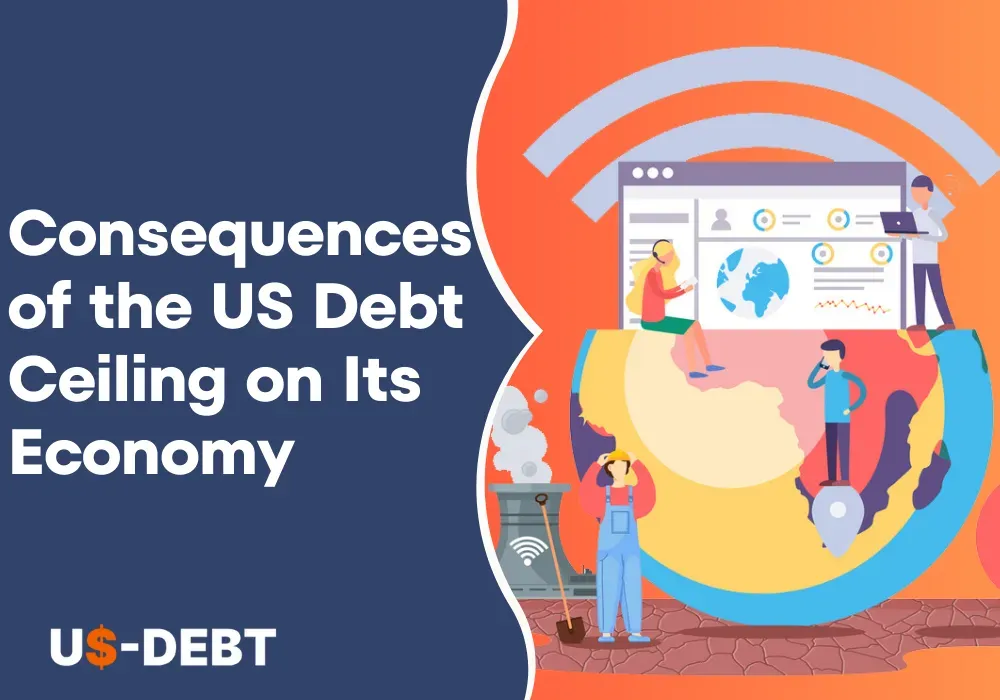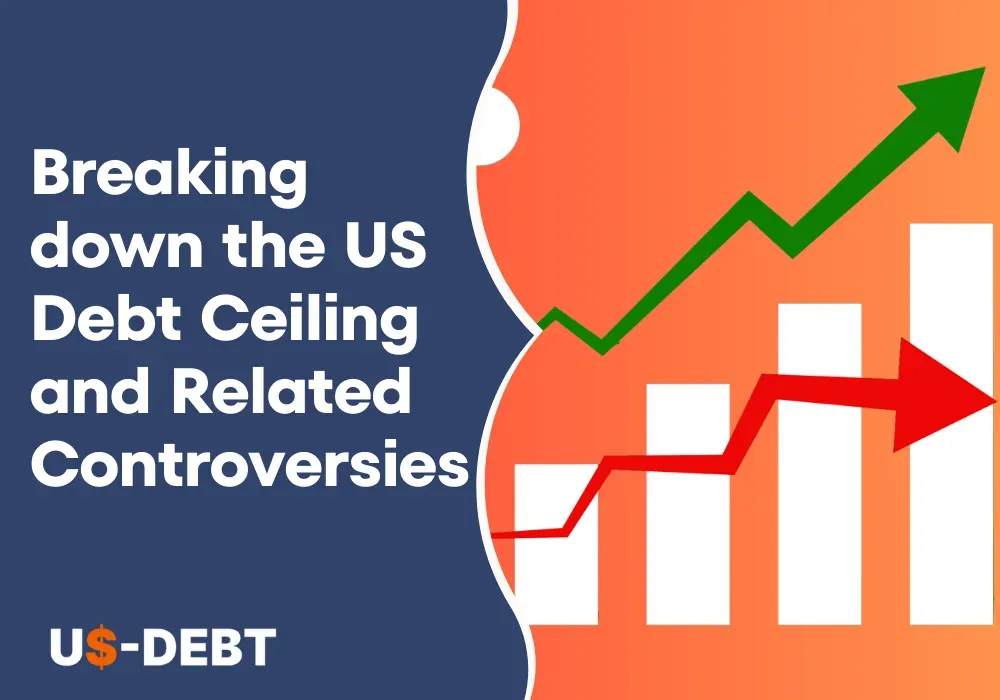The US debt ceiling is a crucial aspect of the country's economic landscape, with significant implications for various sectors and stakeholders. Understanding the consequences of the debt ceiling is essential for comprehending the complexities of the US economy. The consequences of expanding the debt ceiling will be highlighted in this blog article, along with how it will affect government spending and fiscal policy, economic growth, investment, international repercussions, political dynamics, and possible solutions to the debate on this important topic.
Â
Read More:Â US National Debt: A Guide to Understand America's Financial Burden
Â
Consequences of Reaching the Debt Ceiling
Â
Government Shutdown and Its Impact on the Economy
When the debt ceiling is reached, the US Treasury faces constraints in borrowing money to fund government operations. This can lead to a government shutdown, as the government lacks the necessary funds to continue its activities. Such shutdowns can disrupt necessary services, delay payments to government employees and contractors, and negatively affect consumer and business confidence, thereby hampering economic growth.
Â
Default Risk and Its Essences for the US Financial System
Failure to expand the debt ceiling may result in the US government defaulting on its financial obligations. This default risk has severe consequences for the US financial system, including expanded borrowing costs, reduced access to credit, and a potential failure in investor confidence. The resulting financial instability can lead to a deep recession and a prolonged economic downturn.
Â
Effects on Investor Confidence and Financial Markets
Uncertainty surrounding the debt ceiling negatively impacts investor confidence, leading to increased market volatility and potential capital flight. Investors may seek safer assets, causing stock markets to decline and interest rates to rise. The resulting economic instability can reverberate globally, affecting international investors and financial institutions.
Â
Potential Downgrade of the US Credit Rating
Credit rating agencies can lower the credit rating of the US if the nation makes repeated debt defaults or exhibits symptoms of persistent economic mismanagement. A lower credit rating implies higher borrowing costs, reduced investor confidence, and diminished credibility in the global financial market.
Â
Impact on Government Spending and Fiscal Policy
Â
Constraints on Government Spending and Budgetary Decisions
When the debt ceiling hits the maximum perimeter, the government faces restrictions on its capacity to spend. It must prioritize payments, potentially leading to cuts in discretionary spending, delays in social security payments, and reduced funding for vital government programs and services. The resulting austerity measures can adversely affect citizens' well-being and hinder economic growth.
Â
Effects on Government Programs, Including Social Security and Healthcare
The debt ceiling can directly impact government programs such as social security, healthcare, and education. In times of financial constraints, these programs may face reduced funding, resulting in potential service disruptions, delayed benefits, and increased strain on vulnerable populations.
Â
Implications for Fiscal Policy, Taxation, and Budget Deficits
The debt ceiling has the essence for fiscal policy decisions, taxation, and budget deficits. With limited borrowing capacity, the government may resort to higher taxes or increased borrowing costs to fund its obligations. This can have repercussions on private consumption, investment, and overall economic growth.
Â
Economic Growth and Investment
Â
Relationship between the Debt Ceiling and Economic Growth
The consequence of the debt ceiling on economic growth is complex. Uncertainty surrounding the debt ceiling can deter investment, reduce business and consumer confidence, and impede economic expansion. A prolonged debate or failure to address the debt ceiling issue may lead to a lack of fiscal clarity and negatively affect long-term growth prospects.
Â
Effects on Business and Consumer Confidence
When the debt ceiling debate lingers or raises concerns about a potential default, business, and consumer confidence can be significantly undermined. Uncertainty about the government's capacity to meet its financial obligations can cause businesses to delay investment decisions and consumers to trim spending, hampering economic activity.
Â
Impact on Investment Decisions and Economic Stability
The debt ceiling debate can influence investment decisions, particularly in sectors sensitive to government spending. Uncertainty surrounding the debt ceiling may deter private investment, leading to reduced capital expenditure and job creation. Economic stability relies on sustained investment, making it crucial to address the debt ceiling issue promptly.
Â
International Ramifications
Â
Impact on Global Financial Markets and Investor Sentiment
Any interruption brought on by the debt ceiling may have far-reaching effects because the US is a key component of the international financial system. Global financial markets closely monitor the US debt situation, and concerns about default or fiscal instability can lead to market turmoil, affecting investor sentiment and capital flows worldwide.
Â
Influence On the Value of the US Dollar and Foreign Exchange Rates
Any controversy or debate on the subject of the debt ceiling might impact international currency rates and the US dollar's value. The US dollar may decline if the US government's credibility is questioned, which might modify currency exchange rates and potentially disrupt international trade and investment flows.
Â
Implications for International Trade and Economic Diplomacy
The debt ceiling issue can strain international trade relations and economic diplomacy. The US government's inability to meet financial obligations may erode its credibility as a reliable trading partner and influence the negotiating power in international trade agreements.
Â
Political Dynamics and Public Perception
Â
Role of Political Parties and Ideological Differences
The debt ceiling debate often becomes entangled in political dynamics and ideological differences. Political parties may leverage the issue to push their agendas, leading to polarization and gridlock. Such political impasses can hinder timely resolutions and exacerbate the economic consequences of the debt ceiling.
Â
Public Perception and Awareness of the Debt Ceiling
Public understanding and awareness of the debt ceiling can shape the political landscape. Increased public awareness of the implications of the debt ceiling can exert pressure on policymakers to address the issue promptly and responsibly.
Â
Implications for Political Stability and Policy-Making
The debt ceiling issue can impact political stability and policy-making. Heightened uncertainty, prolonged debates, and potential government shutdowns can erode public trust, disrupt policy implementation, and impede long-term economic planning.
Â
Resolving the Debt Ceiling Issue
Â
Historical Approaches to Addressing the Debt Ceiling
In the past, the debt ceiling issue has been resolved through temporary measures, including raising the ceiling, suspending it, or implementing accounting adjustments. These short-term solutions, yet, fail to provide a lasting resolution.
Â
Potential Solutions and Policy Alternatives
Addressing the debt ceiling issue requires a comprehensive and sustainable approach. Policymakers can explore options such as long-term debt ceiling adjustments, bipartisan budget agreements, spending reforms, and increased fiscal transparency to ensure responsible fiscal management.
Â
Challenges and Debates Surrounding the Debt Ceiling Debate
It is well known that the topic of the debt ceiling debate cannot stay away from challenges and controversy. Discussions regarding spending priorities, entitlement programs, tax reforms, and the overall role of government in the economy can shape the contours of the debate. Overcoming these challenges requires constructive dialogue, bipartisan cooperation, and a focus on long-term economic stability.
Â
Conclusion
Reaching the debt ceiling triggers government shutdowns, default risks, and downgrades in credit ratings, leading to economic instability. It influences government spending, fiscal policy, economic growth, investment decisions, and international trade relations. Managing the debt ceiling issue demands careful consideration, political consensus, and long-term resolutions to ensure the stability and growth of the US economy. Policymakers and stakeholders must work together to find sustainable approaches that mitigate the negative impact of the debt ceiling and foster a thriving economic environment.


